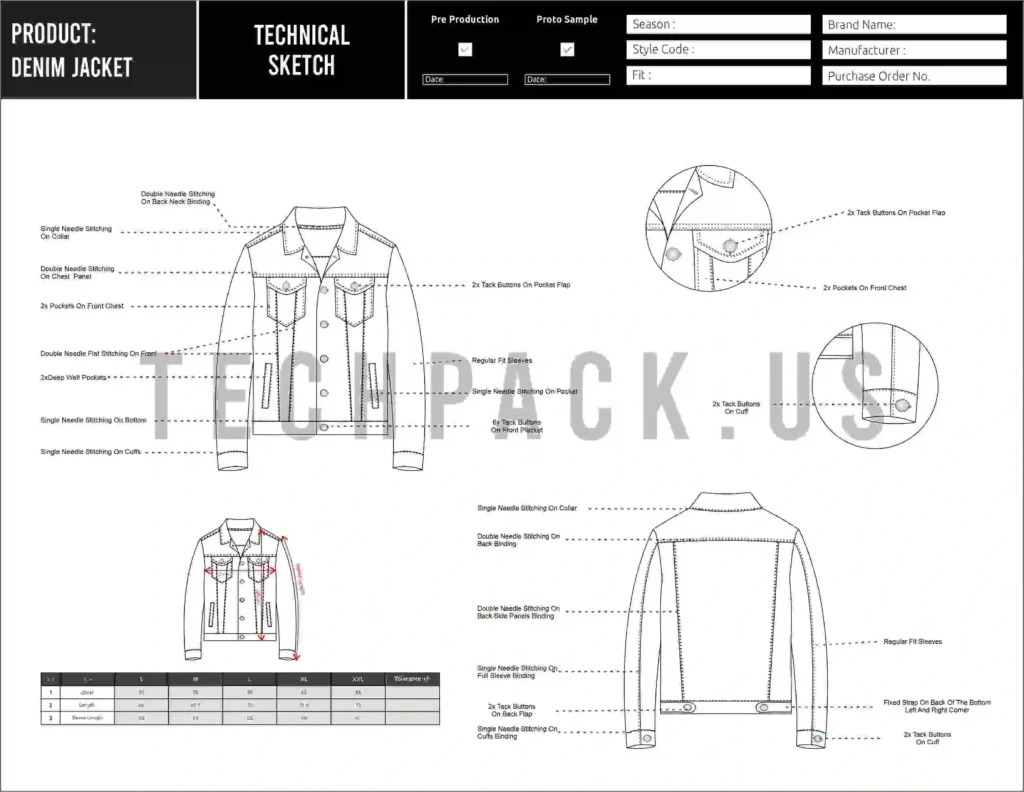In the fashion industry, the victory of any garment lies in the points of interest. A well-prepared tech pack is significant whether you’re a designer, manufacturer, or startup brand. When making a combine of shorts, a comprehensive tech pack streamlines generation, minimizes errors, and guarantees your final product adjusts impeccably with your plan vision. In this web journal, we’ll walk you through how to make a tech pack for shorts, covering all basic components, counting how it fits into the broader context of clothing tech packs and garment tech packs.
What Is a Tech Pack?
A tech pack (short for technical package) is a outline for your garment. It incorporates detailed information approximately your product’s design, construction, materials, and estimations. Basically, it acts as a communication device between creators and manufacturers, making the generation prepare smoother and more efficient.
In the context of shorts, a tech pack guarantees that your plan — from fabric selection to fit and sewing — is interpreted precisely into a physical product.
Why Is a Tech Pack Important for Shorts?

Shorts, though apparently simple, include particular design components such as waistbands, pockets, length choices, and closures (like zippers or drawstrings). A well-made clothing tech pack ensures that each detail is executed accurately, lessening costly back-and-forths and examining errors.
Key benefits include:
Streamlined communication with manufacturers
Accurate cost estimation
Fewer sample revisions
Clear production timelines
Protection of design integrity
Step-by-Step Guide: How to Create a Tech Pack for Shorts

-
Technical Flat Sketches
Start with a detailed level sketch of the shorts — front and back sees. These draws ought to be clean, proportionate, and show the overall shape of the garment. Use vector software like Adobe Artist for professional results.
Include design elements such as:
Pocket styles (slant, welt, patch)
Waistband type (elastic, fixed, with belt loops)
Hem length and shape
Closures (zippers, buttons, drawstrings)
Construction Details
This section outlines how the shorts should be assembled. Specify:
Stitch types (single-needle, double-needle, overlock)
Seams (flat-felled, French seam, etc.)
Placement and types of reinforcements (bar tacks, rivets)
Instructions for finishing hems, waistbands, and pockets
These details ensure the garment tech pack gives manufacturers precise construction guidelines.
Material and Trim Information
List all fabrics, linings, interlinings, and trims (zippers, buttons, labels). Include:
Fabric type and composition (e.g., 100% cotton twill)
GSM (grams per square meter) or weight
Color codes (Pantone or fabric swatches)
Supplier information (optional but helpful)
Providing this info helps maintain consistency and quality.
Colorways and Artwork
If your shorts come in multiple colors or prints, show them clearly in this section. Include:
Colored versions of your flat sketches
Artwork placements (e.g., embroidery, screen prints)
Print scale and technique
This ensures your clothing tech pack captures the full visual range of your design.
Measurement Specs and Size Chart
One of the most critical components. Provide a size chart that lists garment measurements for each size (e.g., S, M, L, XL). Include tolerances (+/- allowed variation) to guide quality control.
Key measurement points for shorts:
Waist (relaxed and stretched, if elastic)
Hip
Inseam and out seam length
Leg opening
Rise (front and back)
Add clear measurement diagrams showing where to measure.
Labeling and Packaging Instructions
Specify:
Brand and care labels (placement and content)
Hangtags and size stickers
Folding methods
Packaging type (polybag, hanger, box)
These details help ensure brand consistency and retail readiness.
Bill of Materials (BOM)
A BOM is a detailed list of all components used in the shorts. Include:
Material name and code
Quantity per unit
Unit of measurement
Supplier (if known)
Example:
| Item | Description | Quantity | Unit | Color | Supplier |
| Fabric | Cotton Twill | 1.2 | meters | Navy Blue | ABC Textiles |
| Zipper | YKK 6″ | 1 | piece | Black | YKK Co. |
Costing Sheet (Optional)
Include estimated costs for materials, labor, trims, and packaging. This helps with pricing decisions and budgeting.
Production Timeline
Map out key production phases:
Sample development
Approvals (fit, color, trims)
Bulk production start
Quality checks
Delivery
Include estimated dates for each milestone to keep everyone on schedule.
Contact Information and Version Control
End your tech pack with:
Contact details of the designer or brand rep
Version number and date
Change log (to track updates and revisions)
This helps manufacturers refer to the latest and most accurate version.
Tips for Creating a Professional Tech Pack for Shorts

- Use consistent fonts and formatting throughout
- Keep all sketches and diagrams to scale
- Organize the tech pack into sections for easy navigation
- Always review and update the tech pack before sending it to production
Conclusion
Creating a detailed tech pack for shorts isn’t fair almost ticking boxes — it’s about setting the establishment for a successful item. From specialized portrays and materials to measuring and construction, each area plays a crucial part. By contributing time into making a comprehensive garment tech pack, you’ll spare costs, dodge generation blunders, and bring your plan to life precisely as intended.
Whether you’re modern to fashion or scaling your brand, acing the art of making a clothing tech pack is a game-changer.
FAQs
Q1: Can I use templates to create a tech pack for shorts?
Yes, there are many tech pack templates available online. However, customizing them to fit your specific design and brand is crucial.
Q2: Do I need technical drawing skills to create a tech pack?
Not necessarily. While it helps, you can also work with a fashion illustrator or use software tools like Adobe Illustrator or Techpacker.
Q3: How detailed should my tech pack be?
The more detailed, the better. Clear, specific information reduces mistakes, ensures quality, and speeds up production.
Q4: What software is best for creating a tech pack?
Popular choices incorporate Adobe Artist, Techpacker, Exceed expectations, and Google Sheets, depending on your workflow and inclinations.
Q5: Is a tech pack required for every garment?
Yes. Each unique garment design should have its own tech pack to ensure accurate production.


